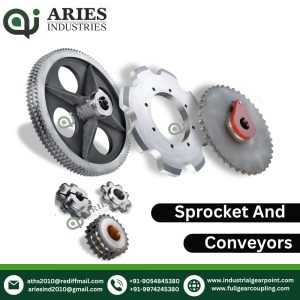What is a Conveyor Chain Sprocket?
Conveyor sprockets are used to transfer power to conveyor chains. Simply put, they are wheels that have teeth that match with a conveyor chain to transmit motion. They come in single, double and up to quintuple formats. Usual specifications for conveyor sprockets are teeth number, bore diameter, hub diameter, outside diameter, hub one side or both, length-through bore and weight.

Choice of material selection depends on transmission of power and speed, operating temperature, exposure to corrosive environments and noise factors. Where noise is a consideration, FB adopts noise reduction tooth profile technology. Conveyor sprockets with hubs made of stainless steel, or hardened steel are commonplace.
What are the parts of a sprocket?
Sprocket teeth – The teeth engage with the bush or roller of a conveyor chain and as the convoy sprocket turns the teeth pull the chain and in the direction of rotation. The number of teeth is determined by outside diameter (OD) It also worth considering that If a sprocket has an even number of teeth, the same tooth will be engaged by the same rollers on each rotation so using an odd number of teeth will increase service life. A similar result will occur if the number of teeth in the smaller sprocket is a divisor of the number of pitches on the conveyor chain.
Bore – Most conveyor chain sprockets are supplied bored and keyed. Also referred to as Bored to Size, these are mounted onto a shaft with a similar keyway to the conveyor chains sprocket. Taper Lock clamping sets can make it easier to assemble and disassemble.
Hub – The hub diameter Is the distance across the hub from one side to another. This can be made to almost any size but must be sized to strength required allowing for keyway and set screws. This diameter must not exceed the pitch circle diameter minus the conveyor chain’s plate height. Chain moving across oversized hubs can result in chain lift from the conveyor chain sprocket’s teeth resulting in more transfer of power. Hubs can be on one or both sides and can be different diameters to suit the application. The width of the hub must be sufficient to allow a long enough key to withstand the torque transmitted by the shaft and maintain the stability of the sprocket on the shaft.
Pitch circle Diameter (PCD) – This is the diameter across to the pitch circle which is the circle followed by the centre line of the chain pins as the conveyor sprocket turns and mesh with the chain.
Tooth Flank – This is the part of the tooth that comes into direct contact with conveyor chain bush or roller and will be the surface which receives the most wear.

Are there standards for conveyor chain sprockets?
There is no stand alone international standard for conveyor chain sprockets. Information on sprockets is generally found in the relevant conveyor chain standard. Using the controlled dimensions in the standard ensure that the correct mesh is in operation and an efficient transmission of load can occur. The following standard maybe useful for reference:
ISO 1977:2006 Conveyor chains, attachments and sprockets
ISO 1275:2006 – Double-pitch precision roller chains, attachments and associated chain sprockets for tansmission and conveyors
ISO 6971:2002 Cranked-link drag chains of welded construction, attachments and sprockets
ISO 6973:1986 Drop-forged rivetless chains for conveyors
BS 4116-4:1992 Conveyor chains, their attachments and associated chain wheels.-Specification for chains and attachments (British series)
DIN 8165-1:1992 Solid Bearing Pin Type FV Conveyor Chains; Single-Strand And Double-Strand Chains
ASME B29.10M-1997 (R2019) Heavy Duty Offset Sidebar Power Transmission Roller Chains And Sprocket Teeth
How do know when a sprocket needs to be replaced?
Once conveyor chain sprockets have worn to a certain degree they can cause rapid chain wear and will need to be replaced at the next available opportunity. Replace them too early however and you’ll be incurring unnecessary costs. By examining the faces of the sprocket teeth you should be able to tell immediately whether a sprocket has worn or not.<//p>
When sprockets are replaced it is essential that they are properly aligned with the shafts as misaligned sprockets are a common cause of premature chain wear. When shafts and sprocket tooth faces are accurately aligned, the load is distributed evenly across the entire chain width which helps to achieve maximum service life. A straight edge, nylon line or laser sight tool should be used across the machined faces of the sprockets in several positions to check for wobble. Once sprockets have been correctly aligned, you should drive the keys home as a final check.

Adjustable sprockets reduce downtime of industrial conveyors
Conveyor system components, from chains to attachments to sprockets, all need to be designed to achieve the optimum balance between durability, resistance to wear and strength. Conveyor chains are often required to operate in harsh environments making an increased reliance in the highest quality materials commonplace. Stringent manufacturing methods are brought into play to avoid unplanned and potentially costly shutdowns.
